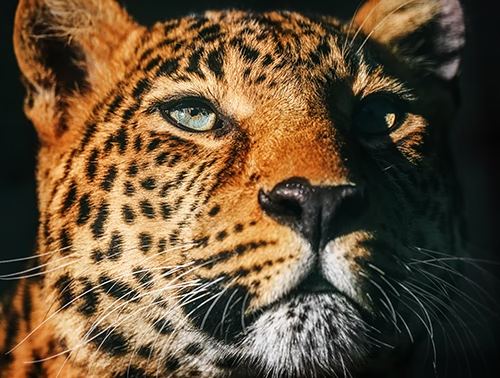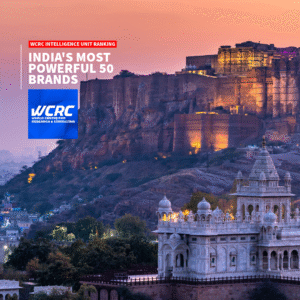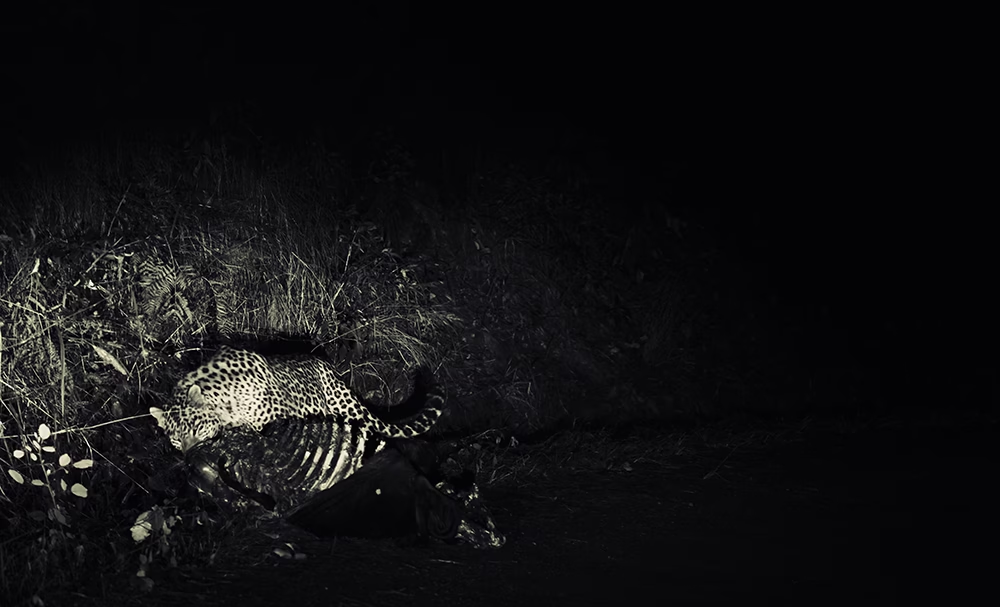In the once-sacred forests of Uttarakhand, an ancient truce is broken—man and beast now wage a war of survival, each haunted by the shadow of the other.
About the Author: Prashanto Banerjee is a conservation and art photographer and a travel writer who runs a ‘K9s for conservation’ project called the Rogue Dog Project that works with forest communities and livestock owners to mitigate and manage human-wildlife conflict

A Prologue: A Land Touched by the Divine
If you were to walk along the mountain trails of Panar at this hour, just as the sun begins to slide off the evening sky, the breathtaking view of the silver peaks set aflame with the last rays of the setting sun would greet you and remind you why the Jaunsaris, so unpretentious in all they own and do, insist on calling their home “the land of the gods.”
That is so, for while you walk these winding trails that hug mountains that pierce the sky, under towering green pines and the broad boughs of russet oaks, along brooks of clear gurgling glacial water that snake their way down the slope, and emerge onto a bugyal with rolling meadows gambolling in the clouds like baby mountains at play, the idea that this world, at least this particular wild world, being the grand design of a divine hand asserts itself even in the most agnostic mind.
And yet, …and yet, I would urge you not to tarry while you admire the view…
As the sun sets and a sudden inky blue shadow creeps up the hills, the cuckoo stops its song and the pheasants disappear in the bushes. The Jaunsari shepherd and his flock hurry round the bend and the women in their Luria skirts and brass nose-rings shuffle hurriedly along the forest trail, brushwood piled high on their little heads, bobbing away in animated loud chatter as they walk down the hill and vanish in the cloak of darkening gloom.
But you, fellow traveller… Are you still standing there by the ridge, catching that cooling breeze as it wafts from the Panar river winding its way along the valley below? Then you might wonder why this lively evening, so full of life and song till about now, has suddenly become so empty. I am surprised no one told you… or maybe they did, but in a tongue you couldn’t catch, for no one who knows these hills and dales wanders these woods alone in the hours that follow the passing of the sun… well, at least not for long.
In the stillness of a now lonely dusk, you rest your fundaments on a milestone and look at the darkening horizon, like an ink laden quill dipped in a limpid sky, washing over the last pink and ochre slivers of sunlight trapped in the sky, like the last strip of shoreline surrendering to the rolling waves of a strident sea.
A rising tide of indigo now owns it all, the silhouetted hills and the dome above, before an invisible hand sprinkles a fistful of silver dust on the sky and it sparkles like diamond spangles on a blue velvet gown. As your city-sore eyes marvel at this miracle one by one, little halos of tungsten light up, a dwelling here, a shed there far on yonder hill, and high up a peak on another, a little under a little flag, perhaps temple – little isolated islands of light across a yawning chasm of determined relentless blackness, like an only ship on an open ocean underscoring the aloneness, an awareness of the otherness in this absence of us-ness.
As stillness and darkness descend on the mountains, enveloping the mountains and that rapid beating heart, that is when you hear it…urrggh-urrgggh! Urrggh-urrgh!! The hacking-cough alarm call of a startled langur. That could mean only one thing – the man-eater is on the prowl again.
The hamlet of Panar, named after the river that winds its way through the region sits high up in a hill facing a remote valley in Almora.
Bala Panua sat on his haunches, quaking in his coarse hill-breeches, teetering on the edge of madness. He had spent the night in the dim airless hut with his weight against the door, praying to all the gods he knew that the beast clawing the door on the other side as it began to splinter, would give up before the door or its hinges gave way. Next to him lay his eighteen year old wife, groaning in agony as she slipped in and out of consciousness, a strip of her saree wrapped around the puncture wounds on either side of her neck and deep lacerations on her right breast where the three inch claws of the man eater had sought traction as he had tried to pull her out head first from the door.
The young couple had left the door open as they slept on that warm April night when the large male leopard had entered the high balcony of the stone house and attempted to carry away the woman, who lay closest to the door. Woken by pain and fear, she held on to her husband for dear life and he instinctively held on to her as he woke. Seeing his wife’s neck in the jaws of the leopard, in spite of his fear, or perhaps because of it, Bala held on to the woman’s arm with one hand, and slammed the heavy door against the leopard’s head with all that remained of his strength. With a snarl, the startled beast let go and Bala slammed the door shut. Within moments, the leopard, perhaps maddened by hunger, or like the villagers now believe, by motives more diabolic, fell upon the door, tearing at it with his claws, punctuated now and then with a low growl that curdled Bala Panua’s blood…
That was more than a hundred years ago. The girl died of her wounds before help could reach her and the Panar man-eater, a huge male leopard, as canny as it was powerful, was to take 454 more lives, as far as government records go, before the ‘Gora Sadhu’ of these mountains, the venerable Edward James Corbett shot the big cat on a grassy knoll at dawn to put an end to the man eater’s reign of terror that spanned more than 500 square kilometres between Pithoragarh and Dabidhura and a period of eight years following a cholera outbreak and lasted till the autumn of 1910.
And A Century Later: Fear Returns to the Hills
Corbett concluded his account of the Panar man-eater with the words… “…and never again were the people of Panar to tread in fear”, but here, the great man was wrong, for the Kumaon is again in the grip of fear. From Almora to Champawat, Pithoragarh to Lansdowne and Dehradun to Dharchula, the hills are still when night falls. Children huddle behind closed doors at night and grown men and women shudder at the thought of stepping outdoors once the shadows are long and the sun has gone.
And the man-eaters have grown bolder. They often strike in daylight, enter school yards and courtyards, not only in remote hamlets high in the mountains but even in big bustling towns and cities. Leopards, man eaters or not, have been trapped, shot at, strung up, burnt alive, and mob-lynched, and yet the human killings continue unabated. It’s like the cats have started a guerilla campaign against mankind and where one succumbs to public justice or a shooter’s bullet, another starts stalking another unwary villager in another corner of the state. Uttarakhand is up in arms against the prince of cats and there’s no Corbett to bring succor or sanity to the region.
What happened in these 100 years that has brought things to such a pass between the generally peaceful hill folk of Kumaon and Garhwal and the leopard, that most adaptable of all big cats, who has learnt to live and thrive in the most varied of landscapes, from high mountains and verdant forest to dry scrubland and even in narrow corridors of green that circle or transverse some of the biggest most crowded cities on the planet? Why has this age old truce between man and cat been torn to shreds by steel and claw? Why are these beautiful valleys simmering with fear, anger and hate and why has this chasm between man and beast grown deeper and wider?
Conservation Versus Survival: A Moral Dilemma
When and how will this war end?
Will exterminating all the leopards that roam these forests and protect these fragile hills from overgrazing by herbivora, thus keeping us safe from landslides and avalanches solve the problem? Or do we let the killings continue, unmindful of the fear and terror that has gripped these hills just because here in our smoke choked cities, we can talk about conservation and the beauty of a leopard’s spots and the grace of its bearing, because when seen through a tv screen, I do not have to worry about seeing the pugmarks of the killer overlapping the foot prints of my school-going children… because I’m not bothered by the sawing of a leopard as I walk into the darkness outside my lamp lit hut to relieve myself under a moonless sky… because I don’t have a man eater clawing at my door all night with my family huddled in the dark, all of us hoping and praying that it picks another house tonight, another hamlet tomorrow night? Is that why I can afford to be appalled by the wanton destruction of this custodian of the forests by poisoning every kill, by the heartless torching of a trapped pregnant leopard without even waiting to wonder or establish if it really is guilty of man eating or just another deer-stalking, boar killing cat doing all its meant to do to keep these hills from becoming dust ? I can see that when the leopard vanishes from these hills, so will the trees, the soil, the very mountains that are home to so many, damming rivers and lives far below, but would I worry so much about day after tomorrow if I fear those jaws clamping around my neck tonight?










